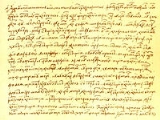
Culture of Romania
Overview
Romania has a unique culture, which is the product of its geography and of its distinct historical evolution. Like Romanians themselves, it is defined as the meeting point of three regions: Central Europe
, Eastern Europe
, and the Balkans
, but cannot be truly included in any of them. Romanian identity is formed on a substratum of mixed Roman
and quite possibly Dacia
n elements, with numerous other influences.
During late Antiquity and Middle Ages, the major influences came from the Slavic peoples
who migrated and settled in near Romania; from medieval Greeks
, and the Byzantine Empire
; from a long domination by the Ottoman Empire
; from the Hungarians; and from the Germans
living in Transylvania.
Central Europe
Central Europe or alternatively Middle Europe is a region of the European continent lying between the variously defined areas of Eastern and Western Europe...
, Eastern Europe
Eastern Europe
Eastern Europe is the eastern part of Europe. The term has widely disparate geopolitical, geographical, cultural and socioeconomic readings, which makes it highly context-dependent and even volatile, and there are "almost as many definitions of Eastern Europe as there are scholars of the region"...
, and the Balkans
Balkans
The Balkans is a geopolitical and cultural region of southeastern Europe...
, but cannot be truly included in any of them. Romanian identity is formed on a substratum of mixed Roman
Ancient Rome
Ancient Rome was a thriving civilization that grew on the Italian Peninsula as early as the 8th century BC. Located along the Mediterranean Sea and centered on the city of Rome, it expanded to one of the largest empires in the ancient world....
and quite possibly Dacia
Dacia
In ancient geography, especially in Roman sources, Dacia was the land inhabited by the Dacians or Getae as they were known by the Greeks—the branch of the Thracians north of the Haemus range...
n elements, with numerous other influences.
During late Antiquity and Middle Ages, the major influences came from the Slavic peoples
Slavic peoples
The Slavic people are an Indo-European panethnicity living in Eastern Europe, Southeast Europe, North Asia and Central Asia. The term Slavic represents a broad ethno-linguistic group of people, who speak languages belonging to the Slavic language family and share, to varying degrees, certain...
who migrated and settled in near Romania; from medieval Greeks
Greece
Greece , officially the Hellenic Republic , and historically Hellas or the Republic of Greece in English, is a country in southeastern Europe....
, and the Byzantine Empire
Byzantine Empire
The Byzantine Empire was the Eastern Roman Empire during the periods of Late Antiquity and the Middle Ages, centred on the capital of Constantinople. Known simply as the Roman Empire or Romania to its inhabitants and neighbours, the Empire was the direct continuation of the Ancient Roman State...
; from a long domination by the Ottoman Empire
Ottoman Empire
The Ottoman EmpireIt was usually referred to as the "Ottoman Empire", the "Turkish Empire", the "Ottoman Caliphate" or more commonly "Turkey" by its contemporaries...
; from the Hungarians; and from the Germans
Transylvanian Saxons
The Transylvanian Saxons are a people of German ethnicity who settled in Transylvania from the 12th century onwards.The colonization of Transylvania by Germans was begun by King Géza II of Hungary . For decades, the main task of the German settlers was to defend the southeastern border of the...
living in Transylvania.
Unanswered Questions

